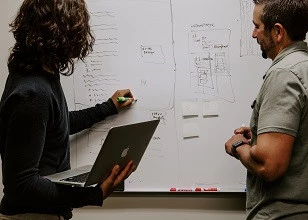Process mining and modeling are two sides of the same coin
Learn why it is critical for process mining and modelling to be utilized in conjunction with one another and leveraged under one platform
Add bookmark
Every organization must constantly change and innovate to remain successful in our competitive, globalized world. Changes can range from comparatively small optimizations to meet new market or industry regulations, to customer-focused business model innovations that can disrupt the underlying industry or even create an entirely new market.
To successfully change and transform organizations, two essential components are required: a strategy and plan for the desired new way of working and crystal-clear visibility into your current modus operandi. 
Process mining and modelling are two sides of the same coin (Source: Software AG)
While a clear strategy and plan sets the bar you want to achieve, a high level of visibility tells you where you are and what you need to change to achieve it. It is like two sides of the same coin; you need both to make a purchase.
Let us take order-to-delivery as an example. Today, customers demand a highly flexible and digitized customer experience which allows them to change their order up to the last possible moment.
Order changes are becoming more of a necessity not only in the stock-to-order business, but also in make-to-order. Take automotive manufacturers, who are forced to allow customers to change their vehicle configuration until very late in the production process. This is because customers may ultimately want to change the color of their car by the time it reaches the paint shop.
In addition to flexibility, customers also demand full visibility into their orders. This applies not only to automotive orders, that can take many months to more than a year in times of global value chain disruption, but also to live tracking of food deliveries.
The flow of process optimization
While any business deploying process mining will be keen to make use of the insights gathered, understanding exactly how to do so can be difficult. Below is an outline of how insights can progress from their initial discovery to delivering real business value.
- The head of sales may be wondering about a drop in customer satisfaction, measured by the Net Promoter Score (NPS) or an increased return rate. They then turn this issue over to a center of excellence (CoE) to determine the root cause of the changing KPIs.
- The CoE determines the customers' need to change placed orders, analyzes how inventory management processes need to be changed and what IT systems such as customer-facing and support mobile apps and online store websites need to be updated to handle the changes. They then model how the underlying process can be redesigned, setting the bar for the transformation.
- The recommended changes are submitted to the head of sales for approval.
- Once approved, the IT department and physical warehouse teams can implement the required changes.
- The corporate education department uses the digitalized process descriptions to effectively communicate the changes to the stakeholders involved. If the underlying IT systems are changed without ensuring that everyone involved in the process is informed, the transformation will cause friction or even worse.
- The CoE can monitor whether the new way of working is being adopted by employees and IT, or whether some sales channels or countries are having difficulty with the changes. This can help them determine if further IT implementation or training is required.
- Finally, the head of sales keeps track of the entire transformation process and can review the improved KPIs in appropriate dashboards.

An illustration of the flow of process optimization – (Source: Software AG)
Leveraging business transformation suites
To successfully drive a transformation, the ARIS process mining suite provides you with all the essential ingredients. In the past, business process management in most organizations focused on either process documentation or process mining, often resulting in tedious or even failing process transformations.
A modeled process landscape in a repository, which serves as the single source of truth, enables everyone in an organization to access and analyze this knowledge pool in a structured way. Understanding how the actual behavior of the underlying processes can be measured and if they still reflect reality is not simple, however.
This is where process mining comes into play as it makes it possible to discover actual process behavior and deviations from standardized processes.
Business transformations can fail if businesses are transforming without considering both sides of the coin, because:
- If businesses only document, how will they understand how processes are executed and discover patterns in customer behaviors that signal issues or inefficiencies.
- If businesses only mine, how do they know what to change about their process, who will be affected and how to effectively roll out the changes?
While an increasing number of companies have already implemented process modeling and mining, the majority still do so in isolation, resulting in lower effectiveness of transformation outcomes or even failed approaches. Here are just some of the reasons this occurs:
- There is no visibility of how the measured reality maps to the already standardized procedures and to planned transformations. It is as if a car’s navigation system were divided into two devices, where one displays the current position and speed while the other displays only the map of the underlying region.
- The transformation process outlined above results in tooling breaks that lead to shadow IT, such as transferring data exports or handling governance tasks in third-party applications.
- Higher IT spending is required because related tasks must be managed in multiple service subscriptions, such as when purchase a spreadsheet and writing software from two different vendors.
In general, it is likely that most businesses learned to love seamlessly integrated office applications no later than when hybrid-working became the new normal. Hence, having modeling and mining split up into separated tools is somewhat like companies working in isolated functions rather than process-driven organizations.

ARIS process mining capabilities – (Source: Software AG)
It will therefore become best practice to establish an integrated transformation platform to gain fact-based, data-driven process insights as well as planning and rollout capabilities to turn plans into actions and ultimately measurable results.
Do you want to learn more about why process mining and process modeling are better together?
Register for Software AG’s free webinar – A highlight will be learning how the Belgian Public Prosecution Service has used ARIS to transform their law enforcement processes.





























































